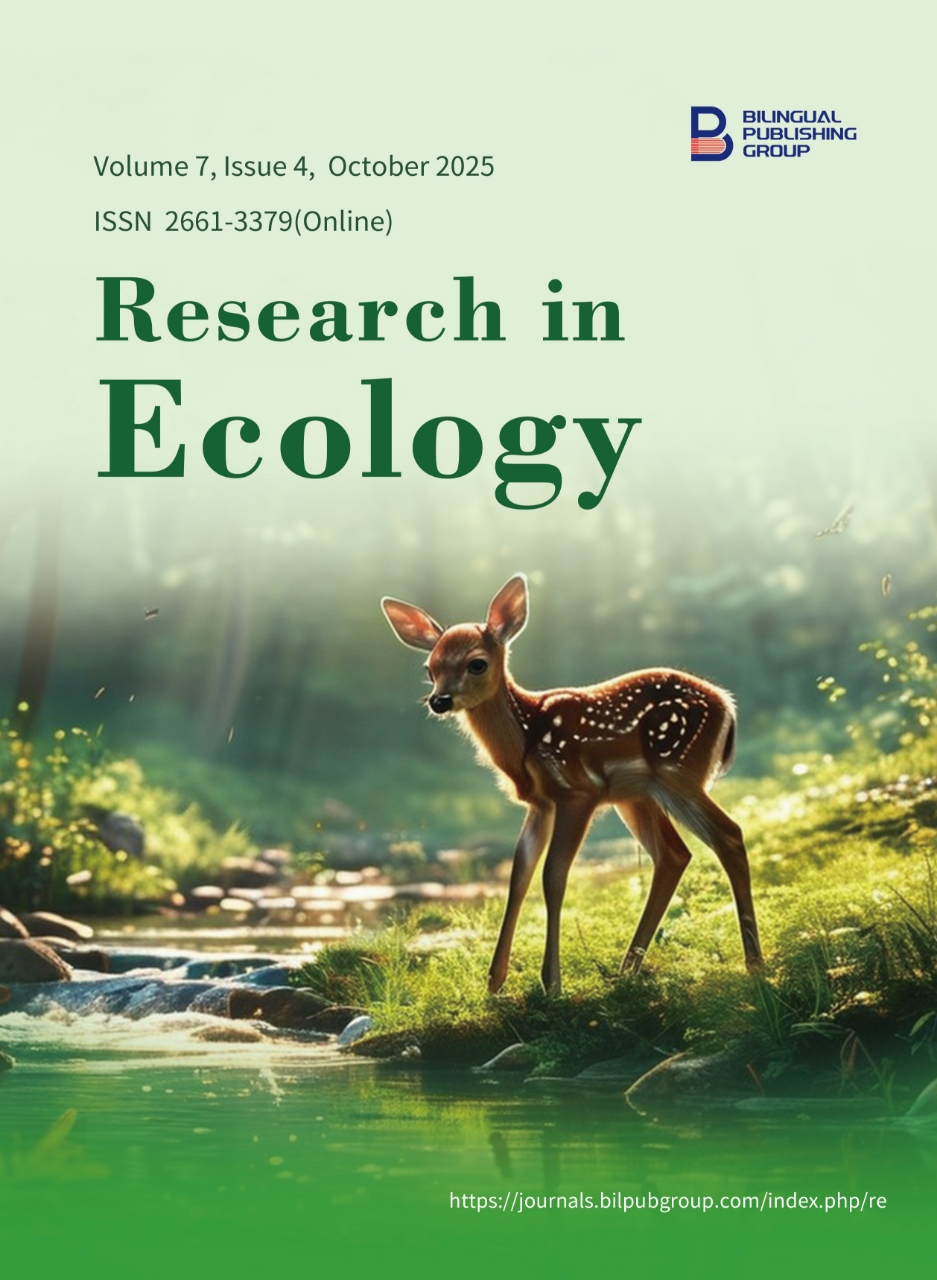
Valuation of Visitors' Perceptions on the Ecosystem Services of Urban Forest Park in Johor, Malaysia
DOI:
https://doi.org/10.30564/re.v7i4.9671Abstract
Urban forest parks deliver a wide spectrum of ecosystem services that support biodiversity, climate regulation, and public well-being; however, their perceived value among local visitors remains underexplored in Southeast Asia. This study investigates visitor perceptions and economic valuation of ecosystem services at Mount Pulai Forest Eco Park in Johor, Malaysia. Grounded in the Total Economic Value (TEV) framework and ecosystem service theory, the research employed a structured on-site survey of 392 visitors and applied the Contingent Valuation Method (CVM) to assess awareness, appreciation, and willingness-to-pay (WTP) for forest conservation. Findings revealed that visitors highly valued regulating services, such as air purification and flood mitigation (mean ≈ 4.3/5), and supporting services, like biodiversity (mean ≈ 4.2/5), while provisioning services were rated lower (mean ≈ 2.8/5). Despite limited familiarity with ecological terminology, only 33% understood the term “ecosystem services”. In contrast, a substantial majority (79.1%) expressed WTP for conservation efforts, proposing an average annual contribution of MYR 51.32. Additionally, 65% of respondents supported an entry fee model, suggesting a mean payment of MYR 3.07 per visit. These results underscore the economic and non-economic value that urban residents assign to forest benefits, offering new insights into conservation finance and public engagement. The study’s innovation lies in its integration of ecosystem perception with economic valuation in an urban forest setting, providing a replicable framework for sustainable park management across Southeast Asia.
Keywords:
Ecosystem Services; Urban Forest; Willingness-to-Pay; Contingent Valuation; Public Perception; Sustainable ManagementReferences
[1] Abas, A., Awang, A., 2017. Air pollution assessments using lichen biodiversity index (LBI) in Kuala Lumpur, Malaysia. Pollution Research. 36(2), 242–249.
[2] Abas, A., Aiyub, K., Idris, N.A., 2020. Systematic review on ecosystem services (Es) of ecotourism in south-east Asia (ASEAN). Problemy Ekorozwoju. Politechnika Lubelska. DOI: https://doi.org/10.35784/pe.2021.1.12
[3] Rosehan, N.S., Abas, A., Aiyub, K., 2020. Studies on the cultural ecosystem services in Malacca City. Planning Malaysia. 18(2), 133–144. DOI: https://doi.org/10.21837/pm.v18i12.749
[4] Costanza, R., De Groot, R., Braat, L., et al., 2017. Twenty years of ecosystem services: How far have we come and how far do we still need to go?. Ecosystem Services. 28, 1–16.
[5] Rosehan, N.S., Abas, A., Aiyub, K., 2022. Systematic review on urban ecosystem services in South-East Asia: ASEAN countries. Problemy Ekorozwoju. 17(1), 256–266. DOI: https://doi.org/10.35784/pe.2022.1.23
[6] Atanga, R.A., Kainyande, A., Tankpa, V., et al., 2024. Perceived status of ecosystem services emanating from a forest reserve: Evidence from Atewa Range Forest Reserve in Ghana. Environmental Management. 73(4), 725–741.
[7] Millennium Ecosystem Assessment, 2005. Ecosystems and Human-Wellbeing Synthesis. Island Press: Washington, DC, USA. pp. 1–155. Available from: https://www.millenniumassessment.org/documents/document.356.aspx.pdf
[8] Johor Forest Department, 2023. Johor Forest Department Annual Report 2023. Available from: https://forestry.johor.gov.my/index.php/info/penerbitan/laporan-tahunan/15-laporan-tahunan-jabatan-perhutanan-negeri-johor-jpnj (cited 16 August 2024).
[9] Nitanan, K.M., Shuib, A., Sridar, R., et al., 2020. The total economic value of forest ecosystem services in the tropical forests of Malaysia. International Forestry Review. 22(4), 485–503.
[10] Samdin, Z., Herman, S., Afandi, M., Yacob, M., 2012. Willingness to pay for conservation fee at Penang National Park. The Malaysian Forester. 75(1), 43–52.
[11] Jamean, E.S., Abas, A., 2023. Valuation of visitor perception of urban forest ecosystem services in Kuala Lumpur. Land. 12(3), 572.
[12] Choi, Y.E., Song, K., Kim, M., et al., 2017. Transformation planning for resilient wildlife habitats in ecotourism systems. Sustainability. 9(4), 487.
[13] Krejcie, R.V., Morgan, D.W., 1970. Determining sample size for research activities. Educational and Psychological Measurement. 30, 607–610.
[14] TEEB, 2010. The Economics of Ecosystems and Biodiversity Ecological and Economic Foundations. In: TEEBWEB. United Nations Environment Programme: Geneva, Switzerland. pp. 1–422. Available from: https://teebweb.org/publications/teeb-for/research-and-academia/
[15] Nishimura, R., Wagner, J., Elliott, M., 2016. Alternative indicators for the risk of non‐response bias: A simulation study. International Statistical Review. 84(1), 43–62.
[16] Mannheim, I., Schwartz, E., Xi, W., et al., 2019. Inclusion of older adults in the research and design of digital technology. International Journal of Environmental Research and Public Health. 16(19), 3718.
[17] Hair, J., Black, W.C., Babin, B.J., et al., 2010. Multivariate Data Analysis: A Global Perspective. Pearson Education: Upper Saddle River, NJ, USA.
[18] Gulsrud, N.M., Hertzog, K., Shears, I., 2018. Innovative urban forestry governance in Melbourne?: Investigating “green placemaking” as a nature-based solution. Environmental Research. 161, 158–167.
[19] Bringezu, S., Potočnik, J., Schandl, H., et al., 2016. Multi-scale governance of sustainable natural resource use—challenges and opportunities for monitoring and institutional development at the national and global level. Sustainability. 8(8), 778.
[20] Fedele, G., Desrianti, F., Gangga, A., et al., 2016. Ecosystem-based strategies for community resilience to climate variability in Indonesia. In: Ecosystem-Based Disaster Risk Reduction and Adaptation in Practice. Springer: Cham, Switzerland. pp. 529–552.
[21] Hausner, V.H., Brown, G., Lægreid, E., 2015. Effects of land tenure and protected areas on ecosystem services and land use preferences in Norway. Land Use Policy. 49, 446–461.
[22] Parker, J., Simpson, G.D., 2018. Visitor satisfaction with a public green infrastructure and urban nature space in Perth, Western Australia. Land. 7(4), 159.
[23] Bryce, R., Irvine, K.N., Church, A., et al., 2016. Subjective well-being indicators for large-scale assessment of cultural ecosystem services. Ecosystem Services. 21, 258–269.
[24] Xia, L., Semirumi, D.T., Rezaei, R., 2023. A thorough examination of smart city applications: Exploring challenges and solutions throughout the life cycle with emphasis on safeguarding citizen privacy. Sustainable Cities and Society. 98, 104771.
[25] Ghazvini, S.A.M., Timothy, D.J., Sarmento, J., 2020. Environmental concerns and attitudes of tourists towards national park uses and services. Journal of Outdoor Recreation and Tourism. 31, 100296.
[26] Chikuta, O., du Plessis, E., Saayman, M., 2023. Universal accessibility of national parks in South Africa and Zimbabwe: Park management perceptions. Tourism Planning & Development. 20(3), 377–396.
[27] Zhang, Y., Hu, F., Zhang, Y., Du, C., Brockington, D., 2023. Exploring the relationship between local participation and perceived co-management performance: Evidence from China’s Giant Panda National Park. Global Ecology and Conservation. 45, e02517.
[28] Kabisch, N., Kraemer, R., Masztalerz, O., et al., 2021. Impact of summer heat on urban park visitation, perceived health and ecosystem service appreciation. Urban Forestry & Urban Greening. 60, 127058.
[29] Mzek, T., Samdin, Z., Mohamad, W.N.W., 2022. Assessing visitors' preferences and willingness to pay for the Malayan Tiger conservation in a Malaysian national park: A choice experiment method. Ecological Economics. 191, 107218.
[30] Costanza, R., De Groot, R., Sutton, P., et al., 2014. Changes in the global value of ecosystem services. Global Environmental Change. 26, 152–158.
[31] Gibson, L.M., Busch, K.C., Stevenson, K.T., et al., 2022. What is community-level environmental literacy, and how can we measure it? A report of a convening to conceptualize and operationalize CLEL. Environmental Education Research. 28(10), 1423–1451.
[32] UNEP, 2021. Becoming #GenerationRestoration: Ecosystem restoration for people, nature and climate. United Nations Environment Programme: Nairobi, Kenya. Available from: https://www.fao.org/documents/card/en/c/cb4927en (cited 8 February 2025).
[33] United Nations World Tourism Organisation [UNWTO], 2021. UNWTO World Tourism Barometer. Available from: https://www.unwto.org/unwto-world-tourism-barometer-data (cited 2 February 2025).
Downloads
How to Cite
Issue
Article Type
License
Copyright © 2025 Miza Farhanah Bilal, Azlan Abas

This is an open access article under the Creative Commons Attribution-NonCommercial 4.0 International (CC BY-NC 4.0) License.




 Miza Farhanah Bilal
Miza Farhanah Bilal






